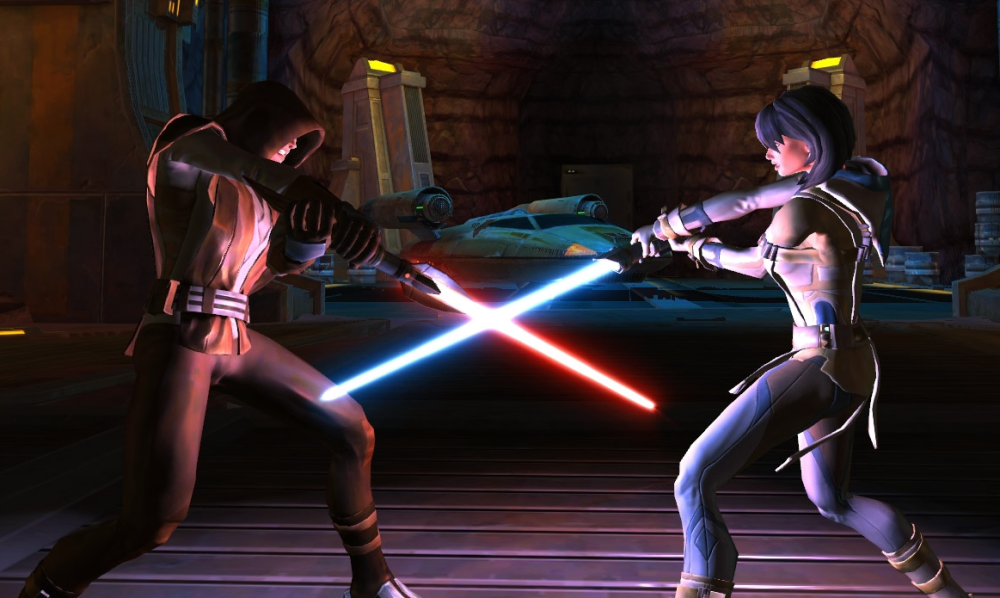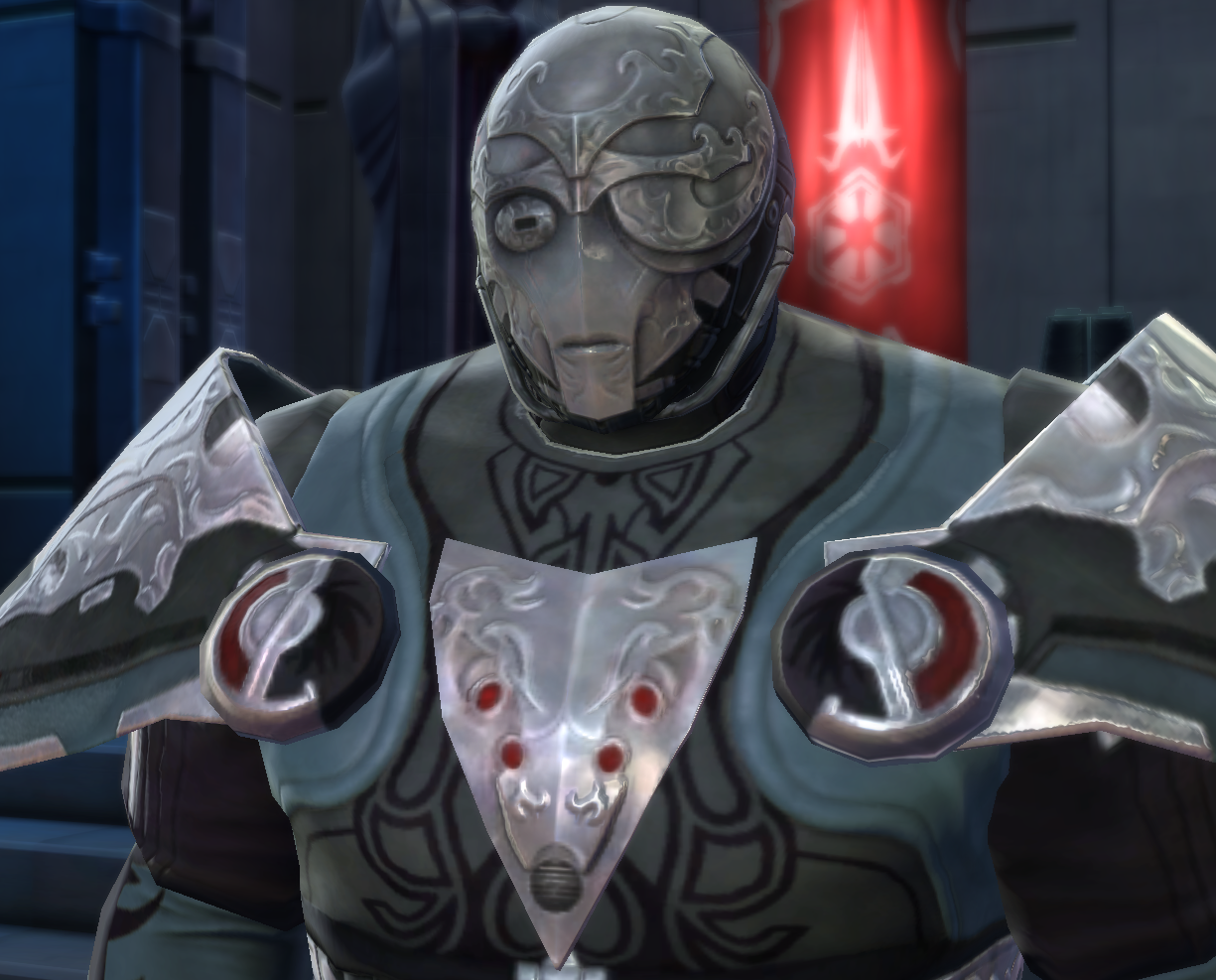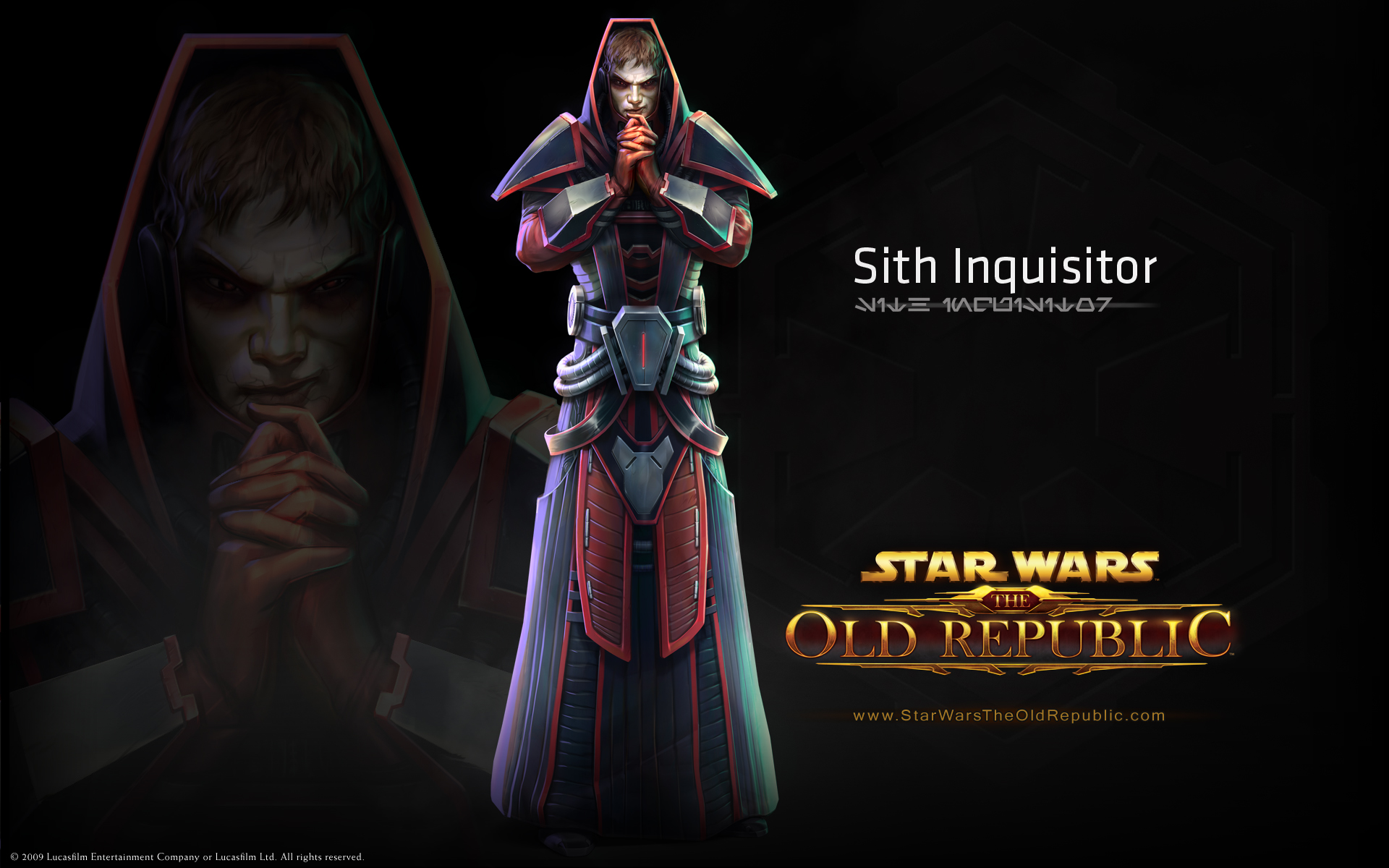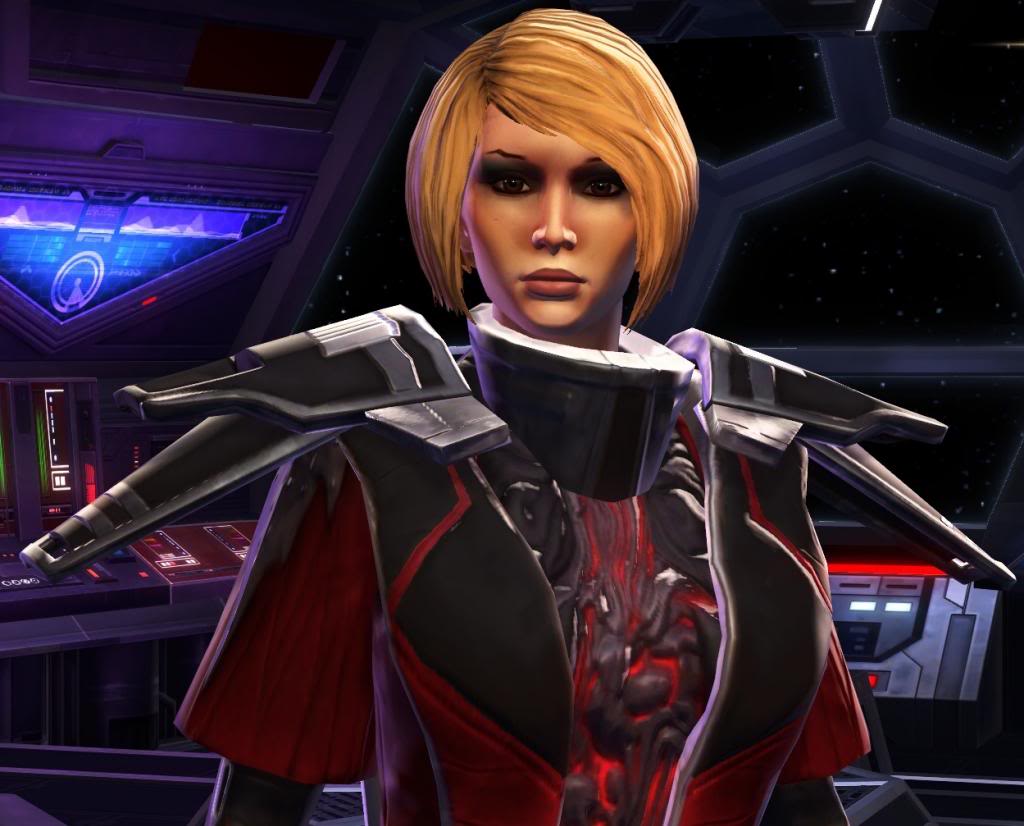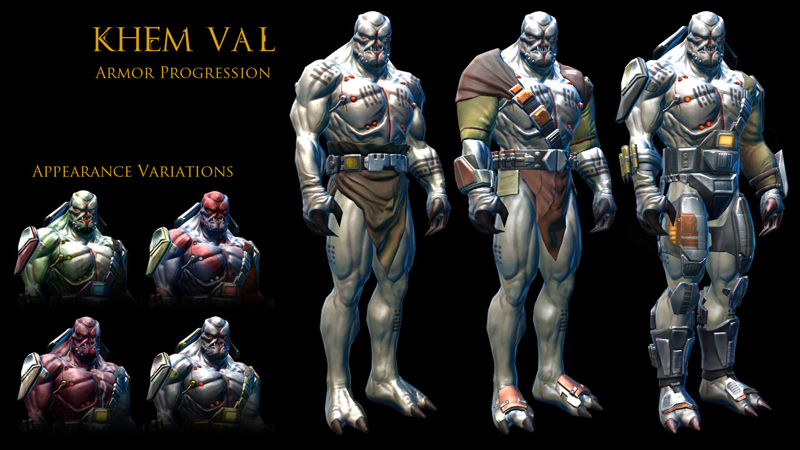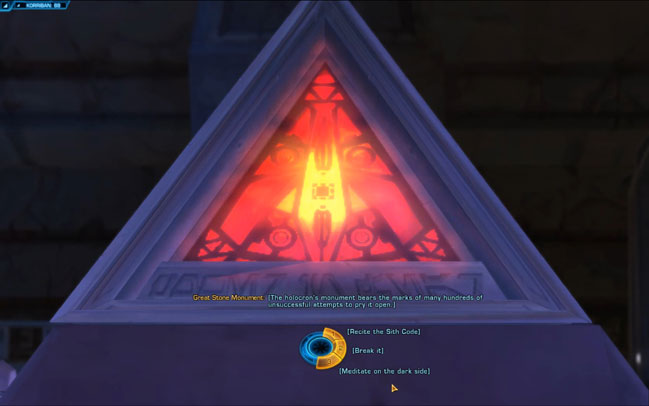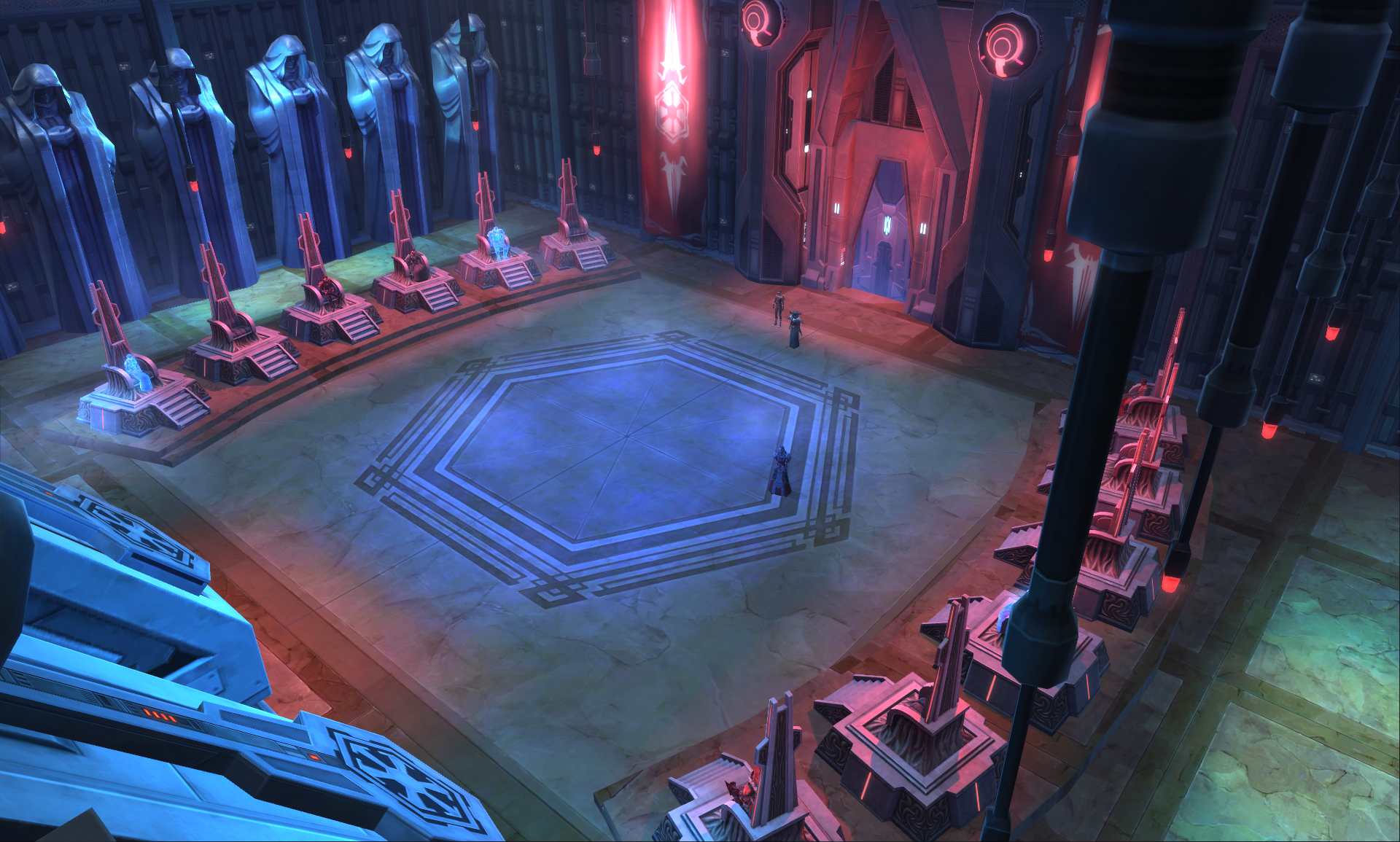More on SWTOR class stories today, as I finished another one last night which gives me a nice grouping to work with. I wanted to talk about these thematically, starting with the “member of a military organization” pair, because I think they work well as story pairs. Part of this is the duality of Republic vs Sith, but really I think it has to do with source material and inspirations.
For this part, I want to go into the Sith Inquisitor and Sith Warrior stories. These two have the clearest source material– Emperor Palpatine and Darth Vader, respectively, and I feel like they live up to their inspirations in interesting ways. They’re also two stories written VERY differently, which I want to talk about a bit, because it’ll come up later when I’m less kind about a particular class story. As before, expect spoilers here.
Without further ado:
SITH WARRIOR
Sith Warrior is, among other things, a story about privilege. You start as an acolyte who is sped through the Sith training process, handed everything on a silver platter, and disliked intensely by your rival, who by all accounts worked hard to get to where he is. From here you move to being the favored apprentice of a powerful Darth, given both free reign and high-profile assignments.
Your first three companions exacerbate this– Vette is a former slave, Quinn is bound by military discipline, and Jaesa is wrapped up in Jedi teachings. You have none of their limitations, which is the source of both their interest in you and conflicts between you and these party members. I bring up companions here because the Sith Warrior’s story is bound into its companions more than any of the others I’ve played. The entirety of Act 1 is a lead-in to Jaesa– you first hear about her at level 13 or 14, and finally acquire her as a party member around level 30, as the crowning finale of Act 1. You are Darth Vader, tempting Luke Skywalker over to the Dark Side, and it takes quite a bit of doing.
This Darth Vader throughline lasts throughout the entire story, and it’s great. You get a lot of moments that feel like you’re a powerful Sith Lord without taking directly from any of the movies. What I get a lot of from the Sith Warrior storyline as well is a sense that my choices matter. Of all of the classes, this is the one I’m most likely to play a second time, because the variance between the Light Side and Dark Side feels pretty significant. Depending on how far to one side or the other you are, the outcome of Act 1 can change drastically, giving you a literally different Jaesa depending on what your choice is.
Act 2 moves in a different direction, with you working to turn the cold war between Republic and Sith into all-out war, at Darth Baras’ direction. You’ve gotten hints all through Act 1 that Baras has plans within plans, and in Act 2 it starts to become apparent that not only is he manipulating the two sides into war, he’s also using the conflict to push his own agenda. Your role in this is eliminating key Republic officials to get the ball rolling and ensure the Sith have a strong position, and by the end of Act 2 you’ve openly gotten a war started, and fought alongside another of Baras’ apprentices to eliminate Baras’ superior and propel him onto the Dark Council. Throughout all of this, Baras is more and more open about how much of a pawn you are, up to and including taking credit for your work when you’re not around. For all that he’s given you, it’s the point where you start to resent him.
Act 3 ramps this up: in your very first mission you’re set up and left to die in a bombed-out cave. It’s blatant that Baras is behind it and expect you to have died, and this Act centers mostly around revenge. You’ve dealt with/heard about a lot of people who have a bone to pick with Baras, and in this chapter you’re working with them to bring down your former master. The timing here is great. Right at the point where you’re tired of taking orders from Baras, you start working against him directly. In this chapter, a bunch of Sith mysticism stuff starts to come into play, but it’s an extremely light touch. Mostly you’re disrupting Baras’ power base, so the details of the mysticism he’s employing aren’t terribly important insofar as you can ruin it.
One of the things I like a lot about Act 3 here is that it inverts a lot of what you’ve gotten used to in the rest of the story. Throughout the storyline’s first and second acts, you land on a planet and get immediate respect and obedience from everyone you talk to, because they’re afraid of Baras, if not you. Starting in Act 3, you no longer have that buffer and people will openly defy you, forcing you to take other routes. It’s a bit of friction that works really well in the story and drives home that underlying theme. No longer propped up by the system, you start working outside of it to get your goals accomplished.
There’s a note about the Sith Warrior that I want to make before moving onto the Inquisitor. This storyline, despite being about a lightsaber-wielding Sith Lord in a Star Wars game, is a fully fleshed out story on its own. You don’t need to know anything about Star Wars to appreciate the story, it stands on its own without the trappings of the setting (much like the Agent and Trooper stories do). Put another way, it’s a good story that happens to be in the Star Wars universe, not good Star Wars that happens to be formed into a story. Moving on:
SITH INQUISITOR
This is a fascinating story when compared to the Sith Warrior, because it’s the opposite in many ways. You start as a slave, who happens to have a talent for the Force and thus gets shuttled off to be a Sith acolyte. Whereas the Sith Warrior is handed success on a silver platter, the Sith Inquisitor is set up for failure from the word go, with an overseer who is openly prejudiced against you and is trying to keep you down. It’s a stark contrast, and when you get matched up with a Darth, there’s the distinct impression that it’s because of your perseverance in the face of adversity, not your raw awesomeness that overcomes your flaws.
Whereas the Sith Warrior presents you with a position that you can be proud of, with others fearing and respecting you, even once you’ve made it as the apprentice of Darth Zash, you’re still criticized and disrespected by other Sith. Zash isn’t as feared or respected as Baras, and as her apprentice you’re even less respected. As a point of comparison– when you first land on Dromund Kaas as a Sith Warrior, you’re met by a groveling servant whose biggest fear is that you won’t tell Baras he did well. As an Inquisitor, your welcome is a face-to-face with another Darth, who threatens you and then laughs in your face if you speak up against him.
Act 1 of the Inquisitor storyline is all about setting the groundwork for a ritual for Zash. Unlike Baras, who is pretty clear in his authority, Zash is almost cloyingly sweet to you unless you back-talk her directly, and you’re warned multiple times, sometimes explicitly, that Zash is going to betray you. This starts early, before level 20, when you wind up in a tomb facing an ancestor of yours. As it turns out, you’re the ancestor of an old Sith Lord whose ghost is interested in maintaining its legacy through you, and helps you out through the story. He warns you first of Zash’s impending betrayal and while you’re working through setting up for Zash’s ritual (which she promises will make you incredibly powerful), he’s providing you defenses against her. Ultimately, when the ritual occurs, it turns out it was a possession ritual– Zash knows you’ll be more powerful than she is so seeks to possess your body, combining her knowledge and your talent. Instead, she winds up possessing one of your companions. More on this a bit later.
The “communing with ghosts” theme runs through the story, and it’s one of the most-criticized aspects of the Sith Inquisitor storyline. Frankly, I think it works– the idea that you’re digging for more power through ancient mysticism is a pretty reasonable one, and since you can’t take power the usual way because the system is keeping you down, you take a more obscure path.
Act 2 of the Inquisitor storyline is about gaining power. Zash’s power play attracted the attention of another Darth, a hyper-traditionalist who seeks to discredit and dishonor Zash and eliminate her entire power base as a posthumous punishment for her arrogance. This includes you, and the start of Act 2 is this new Darth, called Thanaton, trying to get you killed. When this fails, you return and fight him directly and he beats you down pretty thoroughly, using powers you have no real defense against. Act 2 then becomes about finding defenses against Thanaton’s powers, which in this case involves enlisting the aid of other spirits beyond your ancestor. Essentially, you’re taking an extreme shortcut to power by robbing the dead.
It’s at this point that I want to go off on a tangent and talk a bit about the Sith Inquisitor’s companions and supporting NPCs. The companions are (unfortunately) mostly forgettable, and you’re stuck with your first one for quite a while. This companion is a big monster in a loincloth who is disagreeable, talks down to you, and ultimately winds up getting possessed by Zash, which both he and she resent. This companion represents my biggest criticism of the Sith Inquisitor storyline, which comes up a lot. Your first companion, Khem Val, is something called a Dashade, which is some kind of Force-resistant something something Sith assassin something something ancient Sith Lord something. It’s a one-shot of obscure Star Wars lore that’s largely irrelevant to the story but feels like a reference to some obscure piece of Star Wars mythos. This kind of thing litters the Sith Inquisitor storyline, and I think leads to the “ghostbusters” critique you see a lot. On the other hand, a lot of the incidental people you meet on various planets are rather important to the story and quite interesting, and you return to them quite a bit in Act 3. I particularly like the cult you start as a quick route to acquiring an artifact, which keeps returning and being relevant later on.
While the overall arc for the Sith Inquisitor is very good, it suffers from a lot of these one-shot lore bombs, where you’re told about some obscure bit of Star Wars backstory whose only relevance to the story is that it’s the next thing you’re going to go collect. As a result of this, Acts 1 and 2 can feel like a long fetch-quest with some interesting bits laced throughout, because really you’re just going and acquiring ancient power for the first forty levels or so. It boils down to “go to planet, collect artifact/ghost” six or seven times in a row, making the first two arcs feel very repetitive if you aren’t bought into the lore. If you are bought into the lore, it’s a cool lens into some obscure Star Wars mythos, which is where I draw the distinction between the Sith Warrior and Sith Inquisitor storylines. Sith Inquisitor is a bunch of good Star Wars lore mashed together into a story, rather than a good story set in the Star Wars universe.
This changes in Act 3. Having proven that you can stand up to Darth Thanaton and survive at the end of Act 2, Act 3 is about consolidating your powerbase and facing Thanaton for good. There’s a bit of a snag, though, in that your extremely quick route to power is destroying you. While fending off Thanaton and building a solid powerbase, you’re trying to find a cure for the degeneration your stolen power is causing. This takes things in a new direction, where rather than acquiring tchotchkes, you’re following vague hints and scraps of lore for notes. The thread of “obscure Star Wars mythos” continues in this chapter, but it’s directly tied to the story and completely relevant, so they feel a lot more meaningful. Effectively, you’re seeing a technological and spiritual cure for your condition, and as you do so you’re putting together a front against Thanaton.
The Inquisitor Act 3 is an interesting inversion of the Sith Warrior. Up to that point, you’re kind of disrespected as a Sith and often have to use force to get any kind of consideration. In Act 3, between your powerbase and your increasing allies, you’re taken more and more seriously as a legitimate rival to Thanaton, and get the according respect and assistance you might require. You go from being outside the system and the machinations of the Sith to playing a direct part in them, and your allies and powerbase are helping you the entire way through. You finish the story having earned a place on the Dark Council, which is notably a step further than even the Sith Warrior gets. While the Warrior is a lone badass operating outside the lines, the Sith Inquisitor is a legitimate member of the Dark Council with a network of allies and agents spanning quite a few planets.
The big difference in the two that I want to call attention to is that the Inquisitor’s main storyline is possibly the least interesting thing about the class. The writing of the individual planets is far stronger than the overall thread, and the incidental characters you meet are interesting and fun, even when they’re temporary or short-lived. Whereas Sith Warrior has a compelling thread all throughout, Sith Inquisitor has a lot of good moments, even without the thread. Inquisitor’s Act 3 pulls everything together quite nicely, which is also somewhat rare; I tend to dislike Belsavis and Voss on most characters, whereas they’re interesting on the Inquisitor and feel more tied into the class story, as opposed to incidental (they feel INCREDIBLY incidental to the Sith Warrior and Trooper stories).
Of the two, I like the Sith Warrior more, but Inquisitor is also rather good if you buy into the Star Wars mythos it’s built on. I think the use of mysticism is generally fine, but I think Act 3’s direct link between action and lore is stronger than the Acts 1 and 2 lore tie-ins that mostly serve to make it feel like going to a planet and finding some macguffin or another is more interesting. That being said, both deliver on the feeling of being a powerful Vader-type character or a shadowy, schemeing Palpatine figure extremely well, particularly with the payoffs at the end.



